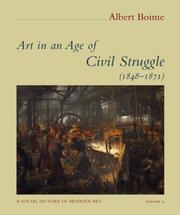| Listing 1 - 3 of 3 |
Sort by
|
Book
ISBN: 3732992748 Year: 2020 Publisher: Berlin : Frank & Timme,
Abstract | Keywords | Export | Availability | Bookmark
 Loading...
Loading...Choose an application
- Reference Manager
- EndNote
- RefWorks (Direct export to RefWorks)
Long description: Le XIXᵉ siècle est le grand siècle du roman : Il est devenu le genre dominant. Le roman raconte les péripéties d’un ou de plusieurs personnages dans un milieu donné. Son contenu est fictif et la dimension artistique est sa caractéristique générale. Dans ce livre Heinz-Peter Endress présente et analyse des oeuvres des romanciers les plus importants du réalisme – „Eugénie Grandet et Le Père Goriot“ de Honoré de Balzac, „Le Rouge et le Noir et La Chartreuse de Parme“ de Henri Beyle, dit Stendhal, „Madame Bovary et L’Éducation sentimentale“ de Gustave Flaubert et „Pierre et Jean et Une Vie ou l’Humble Vérité“ de Guy de Maupassant – comme du naturalisme – „Thérèse Raquin et L’Assommoir“ d’Émile Zola, „Germinie Lacerteux“ des Frères Goncourt et „Le crime de Sylvestre Bonnard“ d’Anatole France. Biographical note: Heinz-Peter Endress est né 1938 à Stuttgart. Après ses études des langues modernes (Anglais, Français, Espagnol) et de la philosophie à Tubingue et Bordeaux il a passé sa thèse de doctorat sur Gustave Flaubert. Endress a été assistant à l’université de Mannheim et professeur agrégé (Akademischer Oberrat) à l’université Albert Ludwig de Fribourg-en-Brisgau. Quatre ouvrages de référence le caractérisent comme un spécialiste de Cervantes. Il est bilingue allemand-français.
Frankreich --- Literaturwissenschaft --- Romanistik --- Realismus --- Gustave Flaubert --- Émile Zola --- Anatole France --- Guy de Maupassant --- Stendhal --- Victor Hugo --- Balzac --- réalisme --- Henri Beyle --- Walter Scott --- Alfred de Vigny
Book
ISBN: 9780810166387 0810166380 9780810128668 0810128667 Year: 2013 Publisher: Evanston, Ill. Northwestern University Press
Abstract | Keywords | Export | Availability | Bookmark
 Loading...
Loading...Choose an application
- Reference Manager
- EndNote
- RefWorks (Direct export to RefWorks)
Focusing on Stendhal, Gérard de Nerval, George Sand, Émile Zola, and Marcel Proust, The Novel Map: Mapping the Self in Nineteenth-Century French Fiction explores the ways that these writers represent and negotiate the relationship between the self and the world as a function of space in a novel turned map.With the rise of the novel and of autobiography, the literary and cultural contexts of nineteenth-century France reconfigured both the ways literature could represent subjects and the ways subjects related to space. In the first-person works of these authors, maps situate the narrator within the imaginary space of the novel. Yet the time inherent in the text’s narrative unsettles the spatial self drawn by the maps and so creates a novel self, one which is both new and literary. The novel self transcends the rigid confines of a map. In this significant study, Patrick M. Bray charts a new direction in critical theory.
Subjectivity in literature. --- Space and time in literature. --- French fiction --- Space and time as a theme in literature --- History and criticism. --- Literature --- Autobiography --- Émile Zola --- Gérard de Nerval --- Indiana --- Les Rougon-Macquart --- Marcel Proust --- Nanon (1938 film) --- Paris --- Stendhal --- Space and time in literature --- Subjectivity in literature --- History and criticism

ISBN: 1281959162 9786611959166 0226063429 9780226063423 9780226063287 0226063283 Year: 2007 Publisher: Chicago University of Chicago Press
Abstract | Keywords | Export | Availability | Bookmark
 Loading...
Loading...Choose an application
- Reference Manager
- EndNote
- RefWorks (Direct export to RefWorks)
From the European revolutions of 1848 through the Italian independence movement, the American Civil War, and the French Commune, the era Albert Boime explores in this fourth volume of his epic series was, in a word, transformative. The period, which gave rise to such luminaries as Karl Marx and Charles Darwin, was also characterized by civic upheaval, quantum leaps in science and technology, and the increasing secularization of intellectual pursuits and ordinary life. In a sweeping narrative that adds critical depth to a key epoch in modern art's history, Art in an Age of Civil Struggle shows how this turbulent social environment served as an incubator for the mid-nineteenth century's most important artists and writers. Tracing the various movements of realism through the major metropolitan centers of Europe and America, Boime strikingly evokes the milieus that shaped the lives and works of Gustave Courbet, Edouard Manet, Émile Zola, Honoré Daumier, Walt Whitman, Abraham Lincoln, and the earliest photographers, among countless others. In doing so, he spearheads a powerful new way of reassessing how art emerges from the welter of cultural and political events and the artist's struggle to interpret his surroundings. Boime supports this multifaceted approach with a wealth of illustrations and written sources that demonstrate the intimate links between visual culture and social change. Culminating at the transition to impressionism, Art in an Age of Civil Struggle makes historical sense of a movement that paved the way for avant-garde aesthetics and, more broadly, of how a particular style emerges at a particular moment.
Art, European --- Art and society --- Art and revolutions --- Realism in art. --- Realism (Art) --- Idealism in art --- Naturalism in art --- Romanticism in art --- Revolutions and art --- Arts and revolutions --- Politics in art --- Art --- Art and sociology --- Society and art --- Sociology and art --- History --- Social aspects --- Realism in art --- 19th century, art history, transformation, transformational, european, europe, america, american, french commune, civil war, independence, karl marx, charles darwin, civic, upheaval, change, science, technology, realism, walt whitman, abraham lincoln, honore daumie, emile zola, edouard manet, gustave courbet, photography, artists, writers, creativity, literature, poetry, aesthetics, cultural, political, interpretation, revolution, slavery, manifest destiny, impressionism.
| Listing 1 - 3 of 3 |
Sort by
|

 Search
Search Feedback
Feedback About UniCat
About UniCat  Help
Help News
News